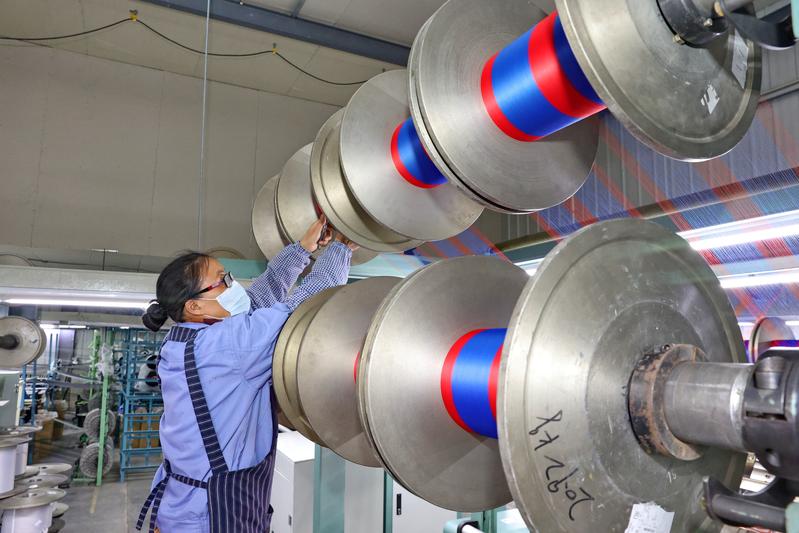China becomes Vietnam's biggest importer of agricultural products
 An employee operates a production machine at a workshop of Jiangsu Golden Autumn Elastic Fabrics Co Ltd in Nantong, Jiangsu province, on April 18. The products are for orders to Vietnam, Pakistan and other countries. (XU CONGJUN / FOR CHINA DAILY)
An employee operates a production machine at a workshop of Jiangsu Golden Autumn Elastic Fabrics Co Ltd in Nantong, Jiangsu province, on April 18. The products are for orders to Vietnam, Pakistan and other countries. (XU CONGJUN / FOR CHINA DAILY)
HANOI — Despite a gloomy global picture featuring rising fuel prices, inflation and disruptions to supply chains, two-way trade between China and Vietnam last year achieved high growth thanks to the implementation of the Regional Comprehensive Economic Partnership.
"Since the RCEP went into effect on Jan 1, 2022, especially after China recently allowed the importation of a number of Vietnamese agricultural products such as durian, bird's nest, sweet potato and passion fruit, Vietnamese enterprises nationwide, including our company, have found big opportunities to export new products to their northern neighbor," Dinh Gia Nghia, deputy general director of Dong Giao Foodstuff Export Joint Stock Co in the northern Ninh Binh province, told Xinhua News Agency in December.
To increase export turnover to RCEP member countries, including China, Vietnamese firms must innovate technology and upgrade designs and product quality, Nghia said. "The RCEP has become a launching pad for us to increase product output and quality, as well as the quantity and value of exports."
His statement was echoed by both local farmers and officials of provinces that export fruit.
"I have just sold five (metric) tons of durian to traders for nearly 80,000 Vietnamese dong ($3.41) per kilogram, doubling the price in the same period last year (2021), thanks to the adoption of stricter cultivation standards," said Nguyen Van Hai, a veteran farmer in the Cai Lay district in the southern province of Tien Giang.
According to Nguyen Van Man, director of the Department of Agriculture and Rural Development of Tien Giang Province, the fact that Vietnamese durian has been exported to China via official channels since September is a contributing factor to higher prices and bigger volumes of the fruit shipped to China.
The Institute of Policy and Strategy for Agriculture and Rural Development under the Vietnamese Ministry of Agriculture and Rural Development said Vietnam earned nearly $50 million from exporting durian to China in October, skyrocketing 4,120 percent against the same period in 2021, an unprecedented increase in the history of the Vietnamese durian sector.
From Sept 17 to Nov 30, over 20,000 tons of the fruit were shipped to China via official channels and the volume is estimated to have surged to 30,000 tons by the end of December, said the institute.
Many Vietnamese companies are expanding material zones and improving fruit quality to boost their exports to China and other RCEP members.
"We are planning to increase the number of certified fruit cultivation areas, and enhancing the processing scale to have a sufficient supply of durian for export year-round, not just in season," Vu Ngoc Huy, deputy general director of Dung Thai Son Import-Export Trading Joint Stock Co in the central highlands province of Dak Lak, told Xinhua in December.
By the end of 2022, the company had 17 facilities for fruit purchasing and packing in Dak Lak and Tien Giang with more than 200 workers, Huy said, adding that its output of processed durian for export is about 50 tons a day.
Van Xuan Phat Import-Export Co in Ho Chi Minh City is also focusing on exporting fruit, especially durian and passion fruit, to China and other RCEP members.
"On Sept 17, we exported the first three containers of durian. After that, every month we export 1,000 tons according to our partners' orders," Nguyen Vu Thang, operation director of Van Xuan Phat Import-Export Co, told Xinhua.
Nghia at Dong Giao Foodstuff Export Joint Stock Co said that on the occasion of the Lunar New Year festival, the demand of the Chinese market accounts for more than 50 percent of Vietnam's fresh fruit exports.
In 2023, Vietnam's fruit and vegetable exports to China may increase by 20 to 30 percent, mainly thanks to smoother transport, quicker Customs clearance, lower tariffs under the RCEP agreement and e-commerce development, Nghia said, adding that his company is looking forward to exporting frozen durian to the neighboring country.
"Besides durian, other fruits such as passion fruit, banana, pineapple and mango still have many opportunities for export growth to China, as long as they meet the requirements of Chinese partners, like complying with full and strict procedures from planting to harvesting, preserving and packing," he said.
The Agency of Foreign Trade under the Vietnamese Ministry of Industry and Trade shared Nghia's view, saying that fruit and vegetable export turnover is expected to become bigger in the future because durian has been allowed to enter China, the biggest importer of Vietnamese fruits and vegetables, under official quotas since September. Bananas will soon follow suit, contributing to bigger overall trade between China and Vietnam.
Vietnam posted foreign trade value of $673.82 billion in the first 11 months of 2022, up 11.8 percent year-on-year, and China was its largest export destination, according to Vietnam's General Statistics Office.
With the RCEP's implementation, trade between Vietnam and other RCEP members, including China, will further surge in the coming years, Vietnamese officials and experts said.


